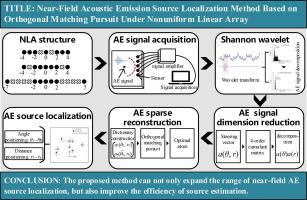当前位置:
X-MOL 学术
›
Mech. Syst. Signal Process.
›
论文详情
Our official English website, www.x-mol.net, welcomes your feedback! (Note: you will need to create a separate account there.)
Near-field acoustic emission source localization method based on orthogonal matching pursuit under nonuniform linear array
Mechanical Systems and Signal Processing ( IF 7.9 ) Pub Date : 2024-07-05 , DOI: 10.1016/j.ymssp.2024.111694 Xin Fang , Guijie Liu , Honghui Wang , Weilei Mu , Yingchun Xie , Xiaojie Tian , Dingxin Leng , Gongbo Li , Guanghao Li
Mechanical Systems and Signal Processing ( IF 7.9 ) Pub Date : 2024-07-05 , DOI: 10.1016/j.ymssp.2024.111694 Xin Fang , Guijie Liu , Honghui Wang , Weilei Mu , Yingchun Xie , Xiaojie Tian , Dingxin Leng , Gongbo Li , Guanghao Li

|
To expand the detectable range of the linear array in the near-field acoustic emission source localization process to improve the localization accuracy and efficiency, this paper proposes a method of near-field acoustic emission source localization based on orthogonal matching pursuit under nonuniform linear array. Firstly, according to the propagation characteristics of acoustic emission signals, a narrowband signal decomposition method for broadband acoustic emission signals is proposed. Then, a near-field source dimension reduction method based on fourth-order cumulants under nonuniform array is proposed to realize the separation and estimation of source angle and distance parameters. Subsequently, an acoustic emission source localization method based on orthogonal matching pursuit is proposed to maximize the source localization performance of the nonuniform linear array. Finally, the performance comparison between three different nonuniform linear arrays and different methods is carried out. Meantime, the finite element simulation and acoustic emission localization experiments are used to analyze the localization accuracy law and verify the effectiveness of the method.
中文翻译:

非均匀线阵下基于正交匹配追踪的近场声发射源定位方法
为了扩大近场声发射源定位过程中线阵的可探测范围,提高定位精度和效率,提出一种非均匀线阵下基于正交匹配追踪的近场声发射源定位方法。首先,根据声发射信号的传播特性,提出了一种宽带声发射信号的窄带信号分解方法。然后,提出一种非均匀阵列下基于四阶累积量的近场源降维方法,实现源角度和距离参数的分离和估计。随后,提出了一种基于正交匹配追踪的声发射源定位方法,以最大化非均匀线阵的声发射源定位性能。最后,对三种不同的非均匀线阵和不同方法进行了性能比较。同时,通过有限元仿真和声发射定位实验,分析了定位精度规律,验证了该方法的有效性。
更新日期:2024-07-05
中文翻译:

非均匀线阵下基于正交匹配追踪的近场声发射源定位方法
为了扩大近场声发射源定位过程中线阵的可探测范围,提高定位精度和效率,提出一种非均匀线阵下基于正交匹配追踪的近场声发射源定位方法。首先,根据声发射信号的传播特性,提出了一种宽带声发射信号的窄带信号分解方法。然后,提出一种非均匀阵列下基于四阶累积量的近场源降维方法,实现源角度和距离参数的分离和估计。随后,提出了一种基于正交匹配追踪的声发射源定位方法,以最大化非均匀线阵的声发射源定位性能。最后,对三种不同的非均匀线阵和不同方法进行了性能比较。同时,通过有限元仿真和声发射定位实验,分析了定位精度规律,验证了该方法的有效性。












































 京公网安备 11010802027423号
京公网安备 11010802027423号